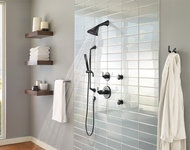As a homeowner, understanding your shower system and its compatibility with existing valves is essential for smooth operation and maintenance. A well-functioning shower system not only ensures a comfortable and enjoyable bathing experience but also helps in preventing potential plumbing issues. Let’s dive into the details, covering aspects like water pressure, valve types, and installation tips, to help you make informed decisions that will keep your shower running efficiently for years to come.
Shower Valve Basics: What You Need to Know
Your shower valve is the unsung hero behind the scenes, controlling water flow, temperature, and pressure. When it comes to compatibility between shower valves and trim, there are some key points to consider.
Not Universally Standardized
Contrary to popular belief, shower valves are not universal. There are several types, each with unique mechanisms and features. The types include:
- Pressure-Balancing Valves which maintain consistent water temperature even if someone flushes a toilet or uses another water source in the house.
- Thermostatic Valves allow precise temperature control and prevent scalding.
- Manual Valves are traditional two-handle or three-handle valves.
Manufacturer Matters
- When replacing a shower valve or updating shower trim, stick with the same manufacturer if you can. Using different brands can lead to compatibility issues. Remember, the valve’s compatibility extends beyond just the visible parts; it affects the internal components too. However, if you plan on completely overhauling the entire shower, you don't have to use the same manufacturer as your previous valve and system.
Identifying Your Existing Valve:
- If you have an older shower faucet, it likely uses old stems. These stems are located behind the handles and are responsible for controlling both the water flow and temperature. Over time, these stems can wear out and may need to be replaced. Stems have largely been replaced by cartridges in more modern faucets, which offer improved reliability and easier maintenance. Understanding the type of mechanism your shower uses can help in troubleshooting any issues and in carrying out necessary repairs.
- Modern shower faucets use cartridges instead of stems. These cartridges combine all the moving parts into a single unit, which greatly simplifies maintenance and repairs. This design not only reduces the need for frequent part replacements but also makes it easier for homeowners to perform basic troubleshooting and fixes on their own.
Check Dimensions and Specifications
- Make sure to measure your existing valve accurately, taking note of all relevant dimensions and specifications such as diameter, length, and material. Additionally, record any unique features or markings. Check manufacturer websites for exact details to ensure you have the correct information before purchasing a replacement.
- When shopping for replacement parts, take the old valve to hardware stores. This ensures you get the correct size and type, making the replacement process smoother and avoiding multiple trips. Properly matching the old valve helps maintain the system's integrity and functionality.
Installation Method
Shower valves can be installed as:
- Two-Handle Valves with separate hot and cold handles.
- Three-Handle Valves allow for systems with separate hot, cold, and diverter handles.
- Single-Handle Valves are for systems with a single lever for both temperature and flow control.
Why It Matters
Choosing the right valve matters for several reasons. Faulty valves can lead to irregular water temperature, pressure problems, and higher water bills. When valves aren't functioning properly, they can cause fluctuations in water flow, resulting in inconsistent temperatures and inefficient use of water. This not only disrupts your daily routines but can also significantly increase your utility costs over time. Regular maintenance and timely replacement of faulty valves are crucial to ensure a smooth and efficient water system.
A compatible valve ensures consistent water temperature and pressure, enhancing your shower experience. By maintaining a stable flow, it prevents sudden fluctuations that could lead to discomfort. This creates a more enjoyable and relaxing environment, allowing you to fully unwind and refresh.
Leaky valves can cause mold and mildew growth, leading to potential health hazards and structural damage. Properly functioning valves are crucial in preventing this by ensuring that moisture does not accumulate, thereby maintaining a safe and healthy environment. Regular maintenance and inspection of valves are essential to avoid such issues.
Conclusion
As a homeowner, understanding your shower valve compatibility is crucial. Take the time to identify your existing valve, consult manufacturer specifications, and choose wisely. Whether you’re replacing a worn-out valve or upgrading your shower, compatibility ensures a hassle-free bathing experience.




